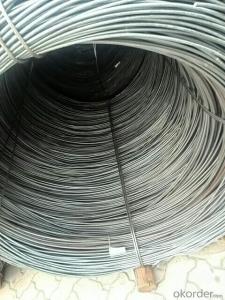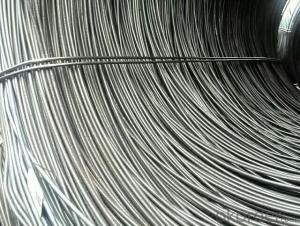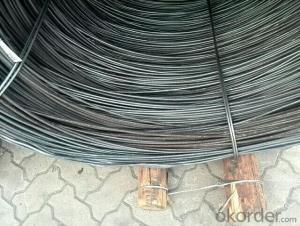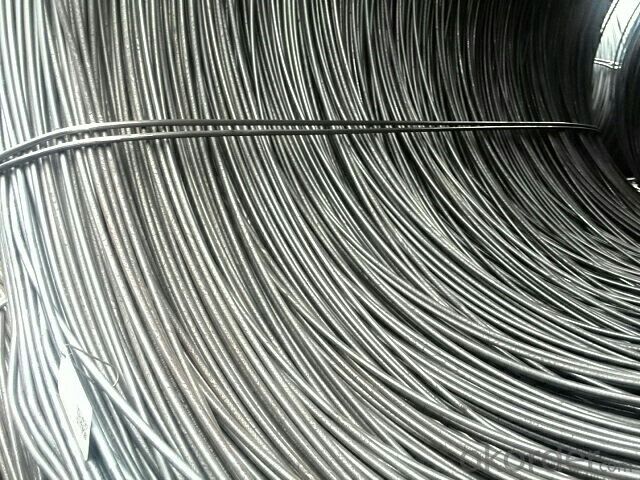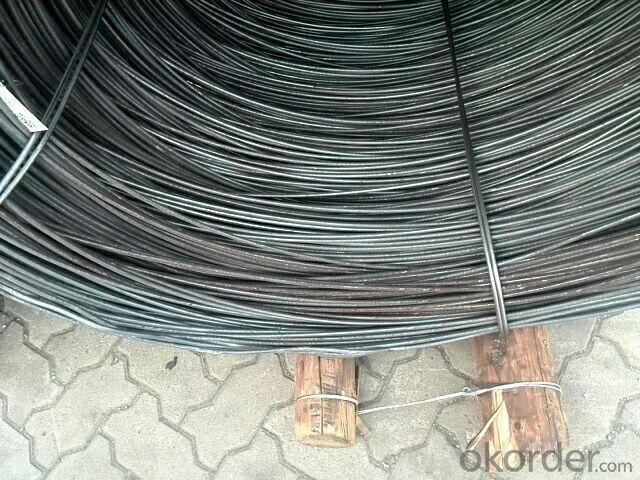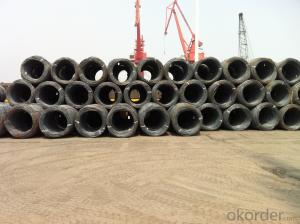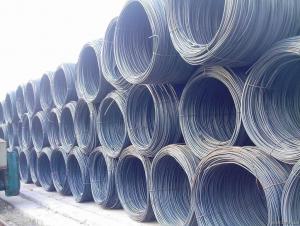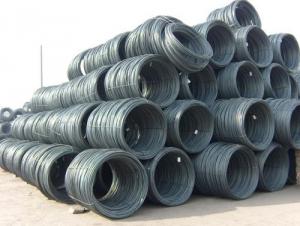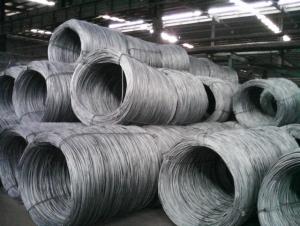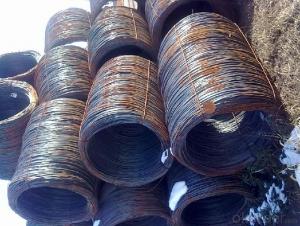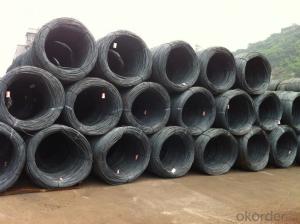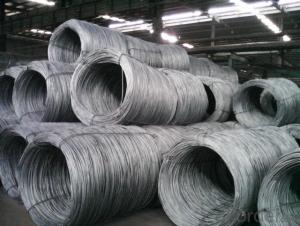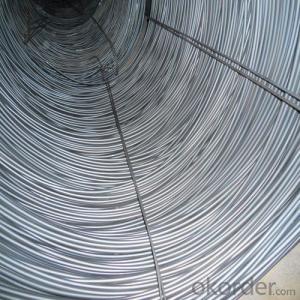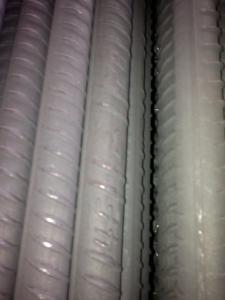Sae1006B and Q235 High quality Wire Rod
- Loading Port:
- Tianjin
- Payment Terms:
- TT OR LC
- Min Order Qty:
- 25 m.t
- Supply Capability:
- 20000 m.t/month
OKorder Service Pledge
OKorder Financial Service
You Might Also Like
Product Description:
OKorder is offering Sae1006B and Q235 High quality Wire Rod at great prices with worldwide shipping. Our supplier is a world-class manufacturer of steel, with our products utilized the world over. OKorder annually supplies products to European, North American and Asian markets. We provide quotations within 24 hours of receiving an inquiry and guarantee competitive prices.
Product Applications:
Sae1006B and Q235 High quality Wire Rodideal for structural applications and are widely used in the construction of buildings and bridges, and the manufacturing, petrochemical, and transportation industries.
Product Advantages:
Sae1006B and Q235 High quality Wire Rod are durable, strong, and resist corrosion.
Main Product Features:
· Premium quality
· Prompt delivery & seaworthy packing (30 days after receiving deposit)
· Corrosion resistance
· Can be recycled and reused
· Mill test certification
· Professional Service
· Competitive pricing
Product Description:
Specifications of Sae1006B and Q235 High quality Wire Rod :
Steel Grade: sae1006+sae1008B , Standard: GB Diameter: 5.5mm, 6.5mm, 7mm,8mm,9mm,10mm,12mm,14mm
Diameter Tolerance:±0.3mm 6.5mm can be drawing into 2mm/8.0mm can be drawing into 3mm
Brand Name: N-RIVER Place of Origin: Hebei, China Mainland Application: construction, building etc
Chemical Composition:
Please kindly find our chemistry of our material based on Q235 as below for your information
Trademark | Rank | Chemical composition (quality score) % | ||||||
C | Si | Mn | S | P | ||||
| ≤ |
| ≤ | ≤ | ||||
Q235 | A | 0.14-0.22 | 0.30 | 0.30-0.65 | 0.050 | 0.045 | ||
Q235 | B | 0.12-0.20 | 0.30 | 0.30-0.70 | 0.045 | 0.045 | ||
Trademark | Rank | Pulling Test | ||||||
Bend PointΔs/Mpa | Tensile Strength | Elongation Ratioδ5% | ||||||
Thickness (Diameter) /MM | Thickness (Diameter) /MM | |||||||
≤16 | 16-40 | ≤16 | 16-40 | |||||
≥ | ≥ | |||||||
Q235 | A | 235 | 225 | 375-500 | 26 | 25 | ||
Q235 | B | 235 | 225 | 375-500 | 26 | 25 | ||
Usage and Applications of Sae1006B and Q235 High quality Wire Rod :
After hot-rolled the products shaped into coil and delivery as finished product, including round, square, rectangular, hexagonal and so on. Since most of the products are round, it is generally called wire rod. Carbon steel wire rod is widely used in construction and manufacturing. Carbon steel wire rod is mainly used for reinforcement of reinforced concrete and welded structure or reprocessed (roberts , nail, etc.) materials, especially used to produce wire drawing, welding electrode, nails, spring, electronic, precise machinery parts and so on.
Packaging & Delivery of Sae1006B and Q235 High quality Wire Rod :
Packaging Detail: products are packed in coil and then shipped by container or bulk vessel
Each coil weight: 2-3MT
Delivery Detail: within 45 days after received deposit or LC.
Label: to be specified by customer, generally, each bundle has 1-2 labels
Trade terms: FOB, CFR, CIF
FAQ:
Q1: Why buy Materials & Equipment from OKorder.com?
A1: All products offered byOKorder.com are carefully selected from China's most reliable manufacturing enterprises. Through its ISO certifications, OKorder.com adheres to the highest standards and a commitment to supply chain safety and customer satisfaction.
Q2: Can stainless steel rust?
A2: Stainless does not "rust" as you think of regular steel rusting with a red oxide on the surface that flakes off. If you see red rust it is probably due to some iron particles that have contaminated the surface of the stainless steel and it is these iron particles that are rusting. Look at the source of the rusting and see if you can remove it from the surface.
Q3: How soon can we receive the product after purchase?
A3: Within three days of placing an order, we will begin production. The specific shipping date is dependent upon international and government factors, but is typically 7 to 10 workdays.
Images:
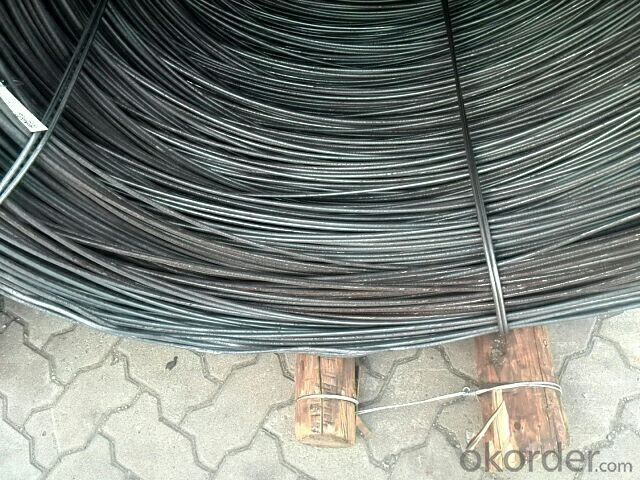

- Q: What are the different types of steel wire rod surface defect classification and grading systems?
- There are several different types of steel wire rod surface defect classification and grading systems, including the ASTM (American Society for Testing and Materials) system, the ISO (International Organization for Standardization) system, and the JIS (Japanese Industrial Standards) system. These systems categorize surface defects based on their type, size, and severity, allowing for a standardized method of assessing and grading the quality of steel wire rods.
- Q: What are the common industry standards for steel wire rod professionals?
- The common industry standards for steel wire rod professionals include adherence to national or international specifications such as ASTM, DIN, or JIS, compliance with quality control measures like ISO 9001, and knowledge of industry best practices and safety protocols.
- Q: What are the different types of wire mesh for architectural use made from steel wire rod?
- There are various types of wire mesh for architectural use made from steel wire rod, including welded wire mesh, woven wire mesh, expanded metal mesh, and perforated metal mesh. Each type offers different features and applications, providing architects with a range of options to suit their specific design requirements.
- Q: How is steel wire rod used in the manufacturing of wire panels?
- Steel wire rod is used in the manufacturing of wire panels as it serves as the primary raw material. The wire rod is processed through various stages, including drawing, annealing, and galvanizing, to transform it into a high-quality wire that is strong and durable. This wire is then woven or welded to create wire panels, which find applications in fencing, construction, agriculture, and other industries.
- Q: How is steel wire rod used in the manufacturing of tire reinforcement?
- Steel wire rod is used in the manufacturing of tire reinforcement by being twisted together to create a strong and durable steel cord. This steel cord is then embedded in the rubber layers of the tire to provide increased strength, stability, and resistance to punctures and impacts. The steel wire rod helps to reinforce the tire structure and improve its overall performance and longevity.
- Q: What are the different types of steel wire rod surface defects and their impact?
- There are several types of steel wire rod surface defects, which include scales, scratches, pits, cracks, and rust. These defects can have various impacts on the quality and performance of the steel wire rod. Scales can reduce the strength and ductility of the rod, while scratches can lead to stress concentration and potential failure under load. Pits can act as stress risers and initiate cracks, compromising the integrity of the wire rod. Cracks can result in catastrophic failure and reduce the overall strength of the rod. Rust, on the other hand, can corrode the surface of the wire rod, reducing its lifespan and structural integrity. Therefore, it is crucial to identify and address these defects to ensure the reliability and quality of steel wire rods.
- Q: What are the main factors influencing the choice of steel wire rod order payment refund options?
- The choice of payment refund options for steel wire rod orders can be influenced by a variety of factors. However, there are several common factors that play a significant role in this decision-making process, including: 1. Supplier Reputation: A crucial factor is the reputation and trustworthiness of the supplier. Buyers often choose payment refund options that provide a sense of security in case of any issues or disputes with the supplier. 2. Order Volume and Value: The size and value of the steel wire rod order can impact the choice of payment refund options. Larger orders with higher values may require more secure refund options to mitigate potential financial risks. 3. Payment Terms and Conditions: The payment terms and conditions set by the supplier can also influence the choice of refund options. Some suppliers may offer specific refund options based on their preferred payment methods, such as bank transfers, letters of credit, or escrow services. 4. Buyer's Financial Capability: The financial capability of the buyer can also determine the choice of refund options. Buyers with limited financial resources may opt for payment refund options that offer flexibility and minimize risks, such as installment payments or delayed payment terms. 5. Delivery and Quality Assurance: The reliability and quality assurance provided by the supplier can impact the choice of refund options. Buyers may prefer refund options that allow them to inspect the steel wire rod upon delivery and ensure compliance with the agreed specifications before making full payment. 6. Market Conditions and Competition: Market conditions and competition among suppliers can influence the choice of refund options. Buyers may consider refund options that are more favorable or competitive in the market, such as cash discounts or rebates. 7. Legal and Regulatory Considerations: Legal and regulatory requirements in the buyer's jurisdiction can also affect the choice of refund options. Buyers may opt for refund options that comply with local regulations and provide legal protection in case of any disputes or non-compliance. Buyers should carefully evaluate these factors and assess their specific needs and preferences before deciding on the most suitable payment refund options for their steel wire rod orders.
- Q: What are the common defects that can occur during the processing of steel wire rod?
- There are several common defects that can occur during the processing of steel wire rod. These defects can affect the properties and performance of the wire rod, making it important to identify and address them: 1. Surface defects: Surface defects can include scratches, pits, cracks, and scale, which can impact the appearance and quality of the wire rod. These defects can occur due to improper handling, rolling, or cooling processes. 2. Internal defects: Internal defects can include inclusions, voids, and segregation. Inclusions are non-metallic particles or impurities that can weaken the wire rod. Voids are internal cavities that reduce the strength and structural integrity of the wire rod. Segregation refers to the uneven distribution of alloying elements, which can result in inconsistent mechanical properties along the length of the wire rod. 3. Dimensional defects: Dimensional defects can include variations in diameter, ovality, and straightness. These defects can occur due to improper rolling, cooling, or handling processes, leading to wire rods that do not meet the required specifications. 4. Decarburization: Decarburization is the loss of carbon from the surface of the wire rod during heating or annealing processes. This can reduce the strength and hardness of the wire rod, affecting its performance in applications requiring high strength. 5. Surface contamination: Surface contamination can occur during the processing of steel wire rod, resulting in the presence of foreign materials such as oil, grease, dirt, or oxide scales. These contaminants can negatively impact the wire rod's surface quality and may lead to issues during subsequent processing or applications. To minimize these defects, it is crucial to have proper quality control measures in place throughout the production process. This includes ensuring the use of high-quality raw materials, implementing effective rolling and heat treatment processes, and conducting regular inspections and testing to identify and rectify any defects that may arise.
- Q: What are the main factors influencing the choice of steel wire rod technical support?
- The choice of technical support for steel wire rod production can be influenced by various factors depending on the specific needs and requirements of the industry or company. However, there are several common factors that play a significant role in the decision-making process. One key factor is the expertise and knowledge of the support provider. It is important for the chosen technical support team to have a deep understanding of steel wire rod production processes, equipment, and technologies. They should possess the necessary experience and expertise to offer guidance and solutions for any technical challenges that may arise during production. Another important factor is the reliability and responsiveness of the technical support team. Given that steel wire rod production processes can be time-sensitive, any technical issues or breakdowns can result in costly production delays. Therefore, having a responsive technical support team that can quickly address and resolve any issues is crucial to ensure a smooth and uninterrupted production. The availability of comprehensive technical support services is also a significant factor to consider. This includes not only troubleshooting and resolving technical issues, but also providing guidance and assistance in areas such as process optimization, equipment maintenance, and quality control. A comprehensive technical support provider can take a holistic approach to enhancing the overall efficiency and productivity of the steel wire rod production process. Cost is another important consideration. Companies need to evaluate the cost-effectiveness of the technical support services offered. This involves considering factors such as the upfront cost of the support, ongoing maintenance expenses, as well as the potential cost savings or productivity improvements that can be achieved through the use of the support services. Furthermore, the reputation and track record of the technical support provider are crucial factors to consider. It is essential to choose a provider with a proven track record of delivering high-quality technical support services to ensure reliability and effectiveness. Lastly, the compatibility and integration of the technical support services with the existing infrastructure and systems should be evaluated. The chosen support provider should be capable of seamlessly integrating their services into the existing production processes and systems, minimizing disruptions and maximizing efficiency. In conclusion, the choice of steel wire rod technical support is influenced by factors such as technical expertise, reliability and responsiveness, comprehensive services, cost-effectiveness, reputation, and compatibility. Considering these factors will enable companies to make an informed decision that meets their specific needs and requirements.
- Q: How are steel wire rods used in the production of wire ropes for cranes?
- Wire ropes for cranes heavily rely on steel wire rods, which act as a crucial ingredient. These rods function as the primary material in the wire rope manufacturing process. Initially, careful selection of steel wire rods is based on their mechanical properties, such as strength and durability. Subsequently, a sequence of processes, including cleaning, heating, and drawing, is applied to transform the rods into wire strands. After the formation of wire strands, they are tightly wound together to create the wire rope. This procedure entails intertwining numerous strands around a central core, typically composed of fiber or steel. The arrangement of the wire strands in a helical pattern enhances both the strength and flexibility of the wire rope. The steel wire rods specifically chosen for the production of wire ropes for cranes possess high tensile strength. This ensures that the wire ropes can endure heavy loads and extreme working conditions. The strength of the steel wire rods directly impacts the overall strength and safety of the wire ropes. Moreover, during the manufacturing process, the steel wire rods undergo various quality control measures to ensure their dependability and consistency. These measures entail testing for tensile strength, breaking load, and other performance parameters. Once the wire ropes are manufactured using the steel wire rods, they find utility in a wide range of crane applications. Wire ropes are indispensable for lifting and transporting heavy loads, providing stability and control throughout crane operations. They play a critical role in the secure and efficient lifting, lowering, and suspension of loads in diverse construction, industrial, and maritime settings. In conclusion, steel wire rods are an essential part of wire rope production for cranes, as they deliver the necessary strength, durability, and reliability required in demanding work environments.
Send your message to us
Sae1006B and Q235 High quality Wire Rod
- Loading Port:
- Tianjin
- Payment Terms:
- TT OR LC
- Min Order Qty:
- 25 m.t
- Supply Capability:
- 20000 m.t/month
OKorder Service Pledge
OKorder Financial Service
Similar products
Hot products
Hot Searches
Related keywords
